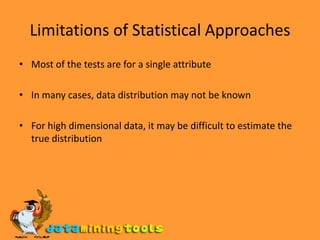Anomaly Detection
- 2. What are anomalies/outliers?The set of data points that are considerably different than the remainder of the dataApplications: Credit card fraud detection, telecommunication fraud detection, network intrusion detection, fault detection
- 3. Variants of Anomaly/Outlier Detection ProblemsGiven a database D, find all the data points x D with anomaly scores greater than some threshold tGiven a database D, find all the data points x D having the top-n largest anomaly scores f(x)Given a database D, containing mostly normal (but unlabeled) data points, and a test point x, compute the anomaly score of x with respect to D
- 4. Anomaly DetectionChallengesHow many outliers are there in the data?Method is unsupervised Validation can be quite challenging (just like for clustering)Finding needle in a haystackWorking assumption:There are considerably more “normal” observations than “abnormal” observations (outliers/anomalies) in the data
- 5. Anomaly Detection Schemes General Steps:Build a profile of the “normal” behaviorProfile can be patterns or summary statistics for the overall populationUse the “normal” profile to detect anomaliesAnomalies are observations whose characteristicsdiffer significantly from the normal profile
- 6. Types of anomaly detection schemesStatistical-based
- 8. Model-basedStatistical ApproachesAssume a parametric model describing the distribution of the data (e.g., normal distribution) Apply a statistical test that depends on Data distributionParameter of distribution (e.g., mean, variance)Number of expected outliers (confidence limit)
- 9. Grubbs’ TestDetect outliers in univariate dataAssume data comes from normal distributionDetects one outlier at a time, remove the outlier, and repeatH0: There is no outlier in dataHA: There is at least one outlierGrubbs’ test statistic: Reject H0 if:
- 10. Statistical-based – Likelihood ApproachAssume the data set D contains samples from a mixture of two probability distributions: M (majority distribution) A (anomalous distribution)General Approach:Initially, assume all the data points belong to MLet Lt(D) be the log likelihood of D at time t
- 11. Contd…For each point xtthat belongs to M, move it to A Let Lt+1 (D) be the new log likelihood. Compute the difference, = Lt(D) – Lt+1 (D) If > c (some threshold), then xt is declared as an anomaly and moved permanently from M to A
- 12. Limitations of Statistical Approaches Most of the tests are for a single attributeIn many cases, data distribution may not be knownFor high dimensional data, it may be difficult to estimate the true distribution
- 13. Distance-based ApproachesData is represented as a vector of featuresThree major approachesNearest-neighbor basedDensity basedClustering based
- 14. Nearest-Neighbor Based ApproachApproach:Compute the distance between every pair of data pointsThere are various ways to define outliers:Data points for which there are fewer than p neighboring points within a distance DThe top n data points whose distance to the kth nearest neighbor is greatestThe top n data points whose average distance to the k nearest neighbors is greatest
- 15. Density-based: LOF approachFor each point, compute the density of its local neighborhoodCompute local outlier factor (LOF) of a sample p as the average of the ratios of the density of sample p and the density of its nearest neighborsOutliers are points with largest LOF value
- 16. Clustering-BasedBasic idea:Cluster the data into groups of different densityChoose points in small cluster as candidate outliersCompute the distance between candidate points and non-candidate clusters. If candidate points are far from all other non-candidate points, they are outliers
- 17. Pros and ConsAdvantages: No need to be supervised Easily adaptable to on-line / incremental mode suitable for anomaly detection from temporal data
- 18. Pros and ConsDrawbacks Computationally expensive Using indexing structures (k-d tree, R* tree) may alleviate this problem If normal points do not create any clusters the techniques may fail In high dimensional spaces, datais sparse and distances between any two data records may become quite similar. Clustering algorithms may not give any meaningful clusters
- 19. conclusionAnomaly detection in data mining is dealt in detail in this presentationTypes of anomaly detection and their merits and demerits are briefly discussed.
- 20. Visit more self help tutorialsPick a tutorial of your choice and browse through it at your own pace.The tutorials section is free, self-guiding and will not involve any additional support.Visit us at www.dataminingtools.net



















